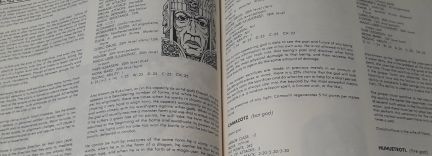Facing the Sacred Direction
It’s been more than a month since I wrote anything that converts content from the AD&D Deities & Demigods for use with 5E D&D. (If you missed those other posts, you can check them out here.) Since I left off with the Celtic Mythos, it’s time to move across the Atlantic and into ancient Mexico for a look at the Central American Mythos.
When we start our look, we find eleven deities and two heroes. Six of those deities are evil, which makes sense given the mind-boggling lust for blood that was part of Aztec life. Of the five remaining deities, two of them are good-aligned. Also, there’s a dearth of material for conversion. I’m not converting deities into 5E versions. I am willing to give it a go with the two heroes, the twins Hunapu and Xbalanque, but I’m going to save them for a later post. So, that leaves me for this post with the last paragraph of the introduction to the Central American Mythos, that explains why “[f]irst level clerics must choose a compass direction for their own (east, west, north or south)”.

Facing the Sacred Direction
A 1st-level cleric that serves a deity of the Central American Mythos must choose a compass direction (east, west, north, or south). Once this choice is made, it cannot be changed. The cleric prays and meditates facing his sacred direction. Failure do so means the cleric regains no spells after resting. Each day, when the cleric starts off to adventure, he must travel at least four steps in his sacred direction before moving in any other direction. Failure to abide by this requirement incurs the deity’s displeasure. At some time during the day, the cleric is sure to experience bad luck (roll with disadvantage on any single attack roll, saving throw, skill check, or ability check of the GM’s choosing). Furthermore, the cleric’s sacred direction dictates the color of his vestments: red for east, yellow for south, black for west, and white for north. These vestments must be worn in plain sight, or else the cleric either suffers disadvantage with spell attack rolls or else his target’s gain advantage on their saving throws against the cleric’s spells until a long rest is spent that includes proper supplications and abasements.
In exchange for these restrictions, the cleric enjoys these benefits when casting a spell while facing his sacred direction:
* The cleric makes spell attack rolls with advantage.
* The cleric’s targets make saving throws against the cleric’s spells with disadvantage.
In situations where the cleric’s facing may not be immediately obvious, simply roll 1d4: 1 equals east, 2 equals west, 3 equals north, and 4 equals south.
******
In Spes Magna news, I’ve ordered the second proof copy of the print-on-demand version of The Four Color Hack. I should have the book in my hands in about a week. If it looks good, the POD version will go on-sale as quickly as possible.
I’ve also released Map Collection II, which presents thirteen hand-drawn maps, including two decades-old campaign maps, one for a historical-fantasy world and the other for a post-apocalyptic world. There are also eleven other maps, including isometric dungeon maps. Each map’s minimalist style maximizes your ability to customize the dungeons. Print a page, and add your own key and encounters for your favorite game. These maps aren’t fancy, but at a about dime each, they’re a bargain. Also, they’re all released under the terms of the AttributionShareAlike 2.0 Generic license.

Leave a Reply